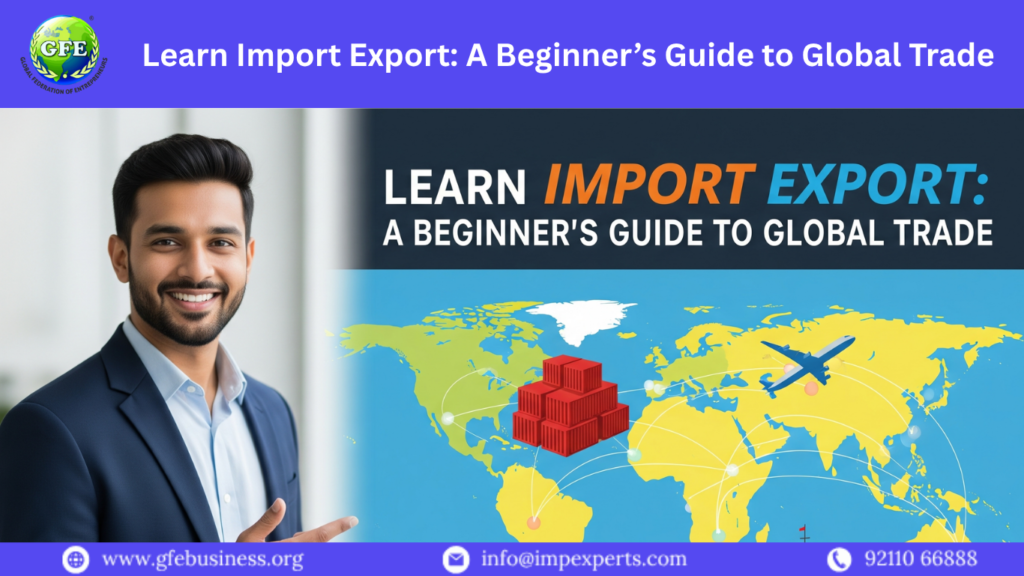Global trade has evolved dramatically in recent years. What was once a domain limited to large companies and government-backed organizations is now open to everyday business owners, students, professionals, and small traders across India. Today, anyone with basic knowledge, access to the internet, and the right guidance can enter the world of import-export.
At GFE Business, we specialize in helping aspiring exporters get started with the tools, training, and support they need to build a sustainable international trade business. If you’re planning to learn import export in 2025, this blog will give you a clear, step-by-step foundation.
Why Should You Learn Import Export in 2025?
The demand for Indian products is increasing around the world. From handicrafts to fresh vegetables, garments to engineering goods, India’s diverse manufacturing and agriculture base makes it a strong player in global trade. Here are a few reasons why learning import export is a smart move right now:
The Indian government is actively promoting exports through subsidies, schemes, and simplified regulations.
Digital platforms now allow even small exporters to connect with global buyers without large marketing budgets.
You don’t need a factory or warehouse to begin — a merchant exporter can start with as little as ₹10,000.
Foreign payments through exports offer higher profitability than domestic trading margins.
Whether you’re a student seeking career growth, a trader wanting to scale, or an entrepreneur building your brand, learning import export opens up real opportunities.
Step-by-Step: How to Learn Import Export as a Beginner
1. Understand the Basics of Import Export
The first step is understanding what the import-export business involves. Export means sending Indian goods to international buyers, while import means bringing products into India from other countries. You can start in either direction, but most beginners choose to start with exports due to higher margins and easier government support.
There are two main types of exporters:
Merchant exporters: Buy goods from Indian manufacturers and sell abroad.
Manufacturer exporters: Produce their own goods and sell internationally.
Learning which model fits your current business or resources will help you plan better.
2. Get Familiar with Export Documentation
The heart of the export business lies in proper documentation. Even a perfect product can be rejected at customs or payments can get stuck if documents are incorrect. As a beginner, you must learn how to prepare and use the following:
Export Invoice and Packing List
Bill of Lading (for sea shipments) or Airway Bill (for air shipments)
Certificate of Origin (COO)
Foreign Inward Remittance Certificate (FIRC)
HS Codes (Harmonized System codes for identifying goods)
GFE Business offers real samples, editable templates, and detailed training so you don’t have to figure this out alone.
3. Set Up Your Business Legally
To begin exporting from India, you need some essential registrations:
IEC (Import Export Code) from the DGFT (Directorate General of Foreign Trade)
GST Registration (if your turnover exceeds the current limit or if you trade domestically)
Current Account in a bank with AD Code registration
Optional: FSSAI license (for food exports), MSME registration, and RCMC (for industry-specific exports)
The good news is that these steps are not costly or time-consuming. Most can be done online in a few days.
4. Identify a Profitable Product
Learning import export also includes learning how to select the right product. Choose something that:
Has consistent demand in the international market
Is easy to source locally at reasonable prices
Has a shelf life suitable for transportation
Can be packed and shipped easily
Examples include handicrafts, spices, herbal products, garments, kitchenware, jute bags, and certain categories of fresh vegetables and fruits.
Conduct basic research on platforms like APEDA, ITC Trade Map, or DGFT trade statistics to see which products are growing in demand.
5. Learn How to Find Genuine Buyers
One of the biggest challenges new exporters face is how to find international buyers. But with the internet, it has become much more accessible.
You can use:
B2B platforms such as Alibaba, Indiamart (export category), Global Sources, and Tradewheel
LinkedIn to search for international importers by product and country
Email and WhatsApp marketing using digital catalogs
Virtual trade fairs and webinars hosted by FIEO, APEDA, and GFE Business
The key is to be consistent in outreach and maintain professionalism in communication.
6. Understand Payment Terms and Logistics
Once a buyer is interested, you must know how to quote prices and handle logistics. Learn the basics of:
Incoterms: FOB (Free on Board), CIF (Cost, Insurance, Freight), DDP (Delivered Duty Paid), and EXW (Ex-Works)
Payment methods: Advance payment, Letter of Credit (LC), Document against Payment (DAP)
Freight and shipping options: Air vs. sea, container load types, international couriers for small orders
Customs clearance and compliance for the destination country
This part of the process can be overwhelming, but GFE Business provides complete walkthroughs so you can execute your first shipment with confidence.
How GFE Business Helps You Learn Import Export
Learning import export alone can take months of trial and error. At GFE Business, we help you cut that time down through structured training, mentorship, and practical support:
Complete beginner-friendly training (online & in person)
Assistance with business and documentation setup
Real buyer finding strategies with templates and follow-up scripts
Access to APEDA registration, export schemes, and subsidy guidance
Lifetime mentorship for handling real trade problems
We don’t just teach — we help you launch and scale.
Final Words
In 2025, learning import export is no longer optional for those who want to grow beyond domestic limits. It’s a practical path to building a high-income, low-investment business with international reach.
Whether you’re in Ahmedabad, Delhi, Rajkot, Pune, or Kolkata — now is the best time to start.
Ready to launch your import export journey?
Visit 👉 www.gfebusiness.org and connect with real trade opportunities. Let’s go global, together.








